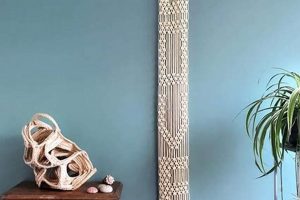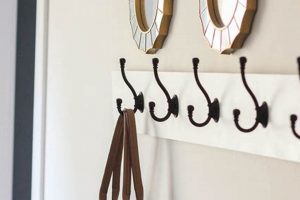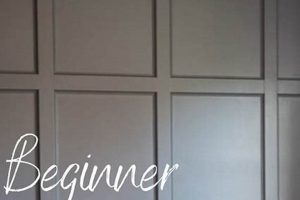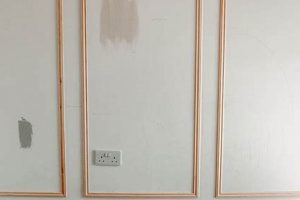The creation of floral backdrops offers an avenue for personalized interior design. These arrangements, often constructed with artificial or preserved botanical elements, provide a customizable aesthetic enhancement for various spaces, ranging from residential interiors to event venues. Such decorative projects allow individuals to tailor visual displays according to specific preferences and spatial requirements, resulting in unique and visually engaging focal points.
The significance of these handcrafted floral installations lies in their capacity to introduce organic textures and visual interest without demanding intensive upkeep. These projects afford an opportunity to express creativity and individuality within a given environment. Historically, floral ornamentation has held cultural importance across diverse societies, and the contemporary adaptation of this tradition allows for a continuation of this artistic expression in modern settings. The benefits of such decorations include the ability to transform ambiance, introduce color palettes, and create memorable visual experiences.
The subsequent sections will detail methodologies for constructing these decorative pieces, exploring various material options, outlining essential tools and techniques, and providing guidance on installation and maintenance procedures. Different design approaches and creative inspirations will also be presented to facilitate the realization of diverse aesthetic visions.
Constructing Floral Backdrops
This section outlines critical considerations for successful creation. Adhering to these guidelines will optimize the visual impact and longevity of the finished product.
Tip 1: Material Selection is Paramount: Opt for high-quality artificial flowers or professionally preserved natural flowers to ensure durability and aesthetic realism. Inexpensive materials often exhibit a lack of visual depth and reduced longevity, ultimately detracting from the overall impact.
Tip 2: Plan the Composition: Prior to assembly, develop a detailed schematic of the intended arrangement. Consider color palettes, flower types, and the desired density of the backdrop. A well-defined plan minimizes errors and ensures a cohesive final product.
Tip 3: Secure Mounting is Critical: Choose a mounting method appropriate for the surface material. Utilize sturdy backing panels, such as plywood or rigid foam, and employ appropriate adhesives or fasteners to prevent detachment and ensure structural integrity. Consider the weight of the final piece when selecting the appropriate hardware.
Tip 4: Employ a Grid System: When adhering individual floral elements, a grid system provides structure and uniformity. This technique ensures consistent spacing and prevents uneven distribution of flowers, resulting in a more polished appearance.
Tip 5: Consider Lighting: Assess the ambient lighting in the intended installation location. Certain artificial flowers may appear differently under varying light conditions. Experiment with different lighting options to ensure the desired aesthetic effect is achieved.
Tip 6: Address Seams and Edges: Pay meticulous attention to the edges and seams of the floral installation. Use additional floral elements or complementary materials to conceal any visible transitions or imperfections. This detail is crucial for a professional-looking finish.
Tip 7: Prioritize Cleanliness: Throughout the construction process, maintain a clean workspace. Residual adhesive, debris, or dust can compromise the final aesthetic and hinder the adhesion of floral elements. Regularly clean surfaces and tools to ensure optimal results.
Adhering to these recommendations will significantly enhance the quality and visual appeal of the constructed piece. Careful planning and execution are essential for creating a lasting and aesthetically pleasing floral installation.
The subsequent sections will discuss advanced techniques for creating unique floral compositions and explore methods for adapting these skills to different decorative projects.
1. Planning and Design
Effective planning and design form the foundational framework for any successful botanical installation. This preliminary stage dictates the aesthetic outcome, structural integrity, and overall longevity of the decorative element. Thorough preparation minimizes errors and ensures a cohesive and visually pleasing final product.
- Conceptualization and Theme Development
The initial phase involves establishing a clear conceptual framework and identifying a unifying theme. This encompasses defining the desired aesthetic, such as minimalist, maximalist, or a specific floral style (e.g., Victorian, contemporary). Theme development guides material selection, color palettes, and overall composition, ensuring a harmonious and intentional final design. For example, a “rustic” theme might necessitate the use of dried flowers and earthy tones, while a “modern” theme could incorporate geometric patterns and bold, contrasting colors.
- Spatial Assessment and Measurement
Prior to material acquisition, a comprehensive assessment of the intended installation space is crucial. Accurate measurements are essential for determining the required dimensions of the backdrop and ensuring proper fit. Consideration should be given to existing architectural features, lighting conditions, and viewing angles to optimize the visual impact. Failure to accurately assess the space can result in a disproportionate or ill-fitting floral installation.
- Material Selection and Procurement Strategy
Informed material selection is a key determinant of both aesthetic quality and structural durability. A detailed procurement strategy should outline the specific types of floral elements, backing materials, adhesives, and mounting hardware required. Consideration should be given to the longevity, colorfastness, and maintenance requirements of chosen materials. Cost-benefit analysis should also be conducted to balance aesthetic goals with budgetary constraints. For example, using UV-resistant materials in sun-exposed locations can significantly extend the lifespan of the decoration.
- Compositional Sketching and Prototyping
Before commencing construction, the development of detailed compositional sketches or digital renderings is highly recommended. This allows for experimentation with different arrangements, color combinations, and visual hierarchies. Creating a small-scale prototype can further refine the design and identify potential challenges related to material manipulation and structural stability. This iterative process minimizes the risk of costly errors and ensures a well-executed final product.
These facets underscore the critical role of diligent planning and design in realizing a visually compelling and structurally sound floral backdrop. A systematic approach, encompassing conceptual development, spatial assessment, material selection, and compositional prototyping, significantly enhances the likelihood of a successful and aesthetically pleasing outcome. The preliminary investment in thorough planning translates into a refined and enduring decorative enhancement.
2. Material Quality Matters
The selection of materials is a paramount consideration in the creation of enduring and aesthetically pleasing floral backdrops. The inherent properties of chosen components directly influence the visual impact, structural integrity, and long-term durability of the finished installation. Compromising on material quality often results in a substandard product with diminished aesthetic appeal and reduced lifespan.
- Visual Realism and Aesthetic Impact
The realism of artificial floral elements significantly impacts the overall aesthetic appeal of the installation. High-quality artificial flowers replicate the intricate details of natural blooms, including variations in petal texture, color gradients, and stem structure. Conversely, inexpensive artificial flowers often exhibit a lack of detail, unnatural colors, and visible manufacturing flaws, detracting from the overall visual quality. The choice of premium materials enhances the visual fidelity of the backdrop, creating a more convincing and aesthetically pleasing decorative element.
- Colorfastness and UV Resistance
Exposure to ultraviolet (UV) radiation from sunlight can cause fading and discoloration in certain materials. Opting for colorfast and UV-resistant artificial flowers and backing materials is crucial, particularly for installations in well-lit areas. Inferior materials are prone to fading over time, resulting in a dull and lifeless appearance. Selecting materials with inherent UV resistance ensures that the color vibrancy and aesthetic appeal of the installation are maintained for an extended period.
- Durability and Structural Integrity
The long-term durability of a floral backdrop is directly dependent on the quality of the chosen materials. High-quality artificial flowers are typically constructed with robust fabrics and sturdy stems, capable of withstanding handling and environmental factors. The backing material, whether it be plywood, foam board, or metal mesh, must possess sufficient strength and rigidity to support the weight of the floral elements. Compromising on material durability can lead to premature degradation, structural failure, and the need for costly repairs or replacements.
- Resistance to Environmental Factors
The selection of materials should consider the specific environmental conditions of the installation location. Artificial flowers intended for outdoor use should be resistant to moisture, mildew, and extreme temperature fluctuations. The backing material should also be capable of withstanding the elements without warping, cracking, or corroding. Choosing materials that are specifically designed for the intended environment ensures the longevity and aesthetic integrity of the floral backdrop.
These considerations underscore the critical importance of material quality in the construction of visually compelling and enduring floral backdrops. Investing in premium materials ensures that the final product exhibits superior aesthetic realism, colorfastness, durability, and resistance to environmental factors, ultimately resulting in a more satisfying and long-lasting decorative enhancement. The initial investment in high-quality materials translates into a long-term return in terms of aesthetic appeal and reduced maintenance requirements.
3. Structural Integrity
Structural integrity forms a foundational element in the creation of enduring floral installations. The inherent stability and load-bearing capacity of the chosen materials and construction techniques directly impact the longevity and visual presentation of the decorative piece. A lack of structural consideration can result in sagging, detachment, and ultimately, the premature failure of the installation. The interconnectedness of individual components necessitates a holistic approach to design and construction, ensuring that the overall framework is capable of supporting the applied weight and withstanding environmental stressors.
Consider, for instance, a large-scale floral wall designed for an outdoor event. The weight of hundreds or thousands of individual floral elements, combined with potential exposure to wind and rain, places significant stress on the supporting structure. If the backing material is insufficiently rigid or the mounting system is inadequately secured, the entire wall is at risk of collapse. In contrast, a smaller, lightweight floral arrangement intended for indoor display requires a less robust framework, but still necessitates a stable base to prevent tipping or accidental damage. The careful selection of materials and construction methods, tailored to the specific application, is crucial for maintaining structural integrity. Real-world examples abound: floral installations in retail spaces often incorporate metal mesh backings for enhanced support, while lightweight foam boards are commonly used for temporary event decorations. The choice depends entirely on the anticipated stresses and the desired lifespan of the installation.
In summary, structural integrity is not merely an abstract concept but a practical necessity for successful floral design. Failure to address this aspect adequately can lead to aesthetically unappealing and potentially hazardous outcomes. By prioritizing robust construction techniques and selecting appropriate materials, creators can ensure that the finished product remains visually impressive and structurally sound for its intended lifespan. This understanding underscores the importance of a thorough planning phase that considers not only the visual design but also the underlying structural framework.
4. Adhesive Properties
Adhesive properties are critical determinants in the construction and longevity of floral wall decor. The selected adhesive directly impacts the securement of floral elements to the backing material, influencing the overall structural integrity and aesthetic presentation of the finished product.
- Bond Strength and Material Compatibility
Adhesive bond strength dictates the force required to separate adhered surfaces. The adhesive must exhibit sufficient bond strength to securely affix the floral elements to the backing material under varying environmental conditions. Crucially, the adhesive must also be chemically compatible with both the floral elements and the backing material. Incompatibility can result in weakened bonds, material degradation, or undesirable chemical reactions. For instance, solvent-based adhesives may damage delicate artificial flowers, necessitating the use of water-based alternatives.
- Setting Time and Application Method
The setting time, or the time required for the adhesive to achieve full bond strength, affects the efficiency of the construction process. Fast-setting adhesives allow for quicker assembly, while slow-setting adhesives provide more time for adjustments and repositioning. The application method, whether it involves spraying, brushing, or direct application, must be appropriate for the adhesive type and the materials being joined. Inadequate adhesive coverage or improper application techniques can compromise bond strength and lead to premature detachment of floral elements.
- Environmental Resistance and Long-Term Performance
Floral wall decor is often subjected to varying environmental conditions, including temperature fluctuations, humidity, and exposure to ultraviolet radiation. The selected adhesive must exhibit resistance to these factors to maintain its bond strength and prevent degradation over time. Adhesives with poor environmental resistance may become brittle, lose adhesion, or discolor, negatively impacting the appearance and longevity of the floral installation. Selecting adhesives specifically formulated for outdoor or humid environments is crucial for long-term performance.
- Toxicity and Safety Considerations
Adhesive toxicity is a significant concern, particularly when constructing floral wall decor in enclosed spaces or with prolonged exposure. The adhesive should be low in volatile organic compounds (VOCs) and free from harmful chemicals that could pose health risks. Proper ventilation should be maintained during application, and appropriate safety precautions, such as wearing gloves and eye protection, should be followed. Prioritizing non-toxic adhesives and adhering to safety guidelines ensures a safe and healthy construction environment.
The facets of adhesive propertiesbond strength, setting time, environmental resistance, and safetydirectly influence the success of floral wall decor projects. Careful consideration of these properties, coupled with informed material selection and proper application techniques, is essential for creating visually appealing and durable decorative installations. The seemingly small detail of adhesive choice plays a pivotal role in the overall quality and longevity of the floral artwork.
5. Color Coordination
Color coordination is a central element in the design and execution of floral wall decorations. The strategic use of color palettes determines the aesthetic impact, visual harmony, and overall success of the decorative installation. Thoughtful color selection contributes significantly to the creation of a visually compelling and cohesive final product.
- Establishing a Dominant Color Palette
The selection of a dominant color palette serves as the foundation for the floral arrangement. This involves identifying the primary colors that will dictate the overall tone and mood of the decoration. For instance, a pastel palette might evoke a sense of tranquility and softness, while a vibrant, contrasting palette could create a more energetic and dynamic visual statement. The dominant color palette should be chosen to complement the existing interior decor and align with the intended aesthetic goal. In a neutral-toned room, a bold floral arrangement could serve as a focal point, while a more subdued color scheme might be preferable in a room with existing colorful elements.
- Employing Color Theory Principles
Application of color theory principles, such as complementary, analogous, and triadic color schemes, can enhance the visual harmony and depth of the floral arrangement. Complementary colors, located opposite each other on the color wheel, create a strong contrast and visual interest. Analogous colors, situated adjacent to each other, offer a more subtle and harmonious blend. Triadic color schemes, using three colors equally spaced on the color wheel, provide a balanced and vibrant composition. Understanding and applying these principles allows for the creation of visually sophisticated and aesthetically pleasing color combinations within the floral wall decor.
- Considering Texture and Light Reflection
The interplay between color, texture, and light reflection significantly influences the perceived visual effect of the floral arrangement. Different textures can affect how colors are perceived; for example, a matte texture will absorb light, resulting in a more subdued color appearance, while a glossy texture will reflect light, enhancing the color vibrancy. Furthermore, the direction and intensity of light sources can alter color perception, highlighting certain hues and casting shadows that add depth and dimension to the arrangement. Careful consideration of these factors ensures that the chosen colors interact harmoniously with the surrounding environment and lighting conditions.
- Balancing Warm and Cool Tones
The balance between warm and cool color tones plays a crucial role in establishing the overall mood and atmosphere of the floral wall decor. Warm colors, such as reds, oranges, and yellows, tend to evoke feelings of warmth, energy, and excitement, while cool colors, such as blues, greens, and purples, create a sense of calmness, serenity, and sophistication. A well-balanced color scheme incorporates both warm and cool tones to create a visually engaging and harmonious composition. For example, a predominantly cool-toned arrangement can be enlivened by incorporating small accents of warm colors, adding visual interest and preventing the overall design from feeling too sterile or monotonous.
The integration of these color coordination principles is vital for achieving a visually compelling and aesthetically pleasing piece of decorative wall art. The success of floral wall decor is intimately linked to the strategic application of color theory, texture, and light, culminating in a harmonious and impactful design.
6. Floral Arrangement
Floral arrangement stands as a core component within the broader context of handcrafted floral wall decor. The systematic organization of botanical elements directly influences the aesthetic appeal, visual harmony, and overall impact of the finished installation. Proficiency in arrangement techniques is essential for creating visually compelling and structurally sound pieces of decorative art.
- Symmetry and Asymmetry in Design
The choice between symmetrical and asymmetrical arrangements dictates the overall visual balance and formality of the floral decor. Symmetrical arrangements, characterized by mirrored elements on either side of a central axis, often convey a sense of order and elegance. Asymmetrical arrangements, employing uneven distribution of elements, can create a more dynamic and naturalistic effect. The selection of symmetry or asymmetry depends on the desired aesthetic and the intended spatial context of the installation. Formal settings may benefit from symmetrical designs, while more casual spaces may be better suited to asymmetrical arrangements.
- Focal Point and Visual Hierarchy
Establishing a clear focal point is essential for guiding the viewer’s eye and creating visual interest. This can be achieved by strategically placing larger, more visually striking floral elements or by using contrasting colors and textures to draw attention to a specific area. The focal point should be balanced within the overall arrangement, creating a visual hierarchy that leads the eye through the composition. A well-defined focal point prevents the arrangement from appearing chaotic or disjointed.
- Layering and Depth Creation
Layering involves arranging floral elements at varying depths to create a sense of dimension and visual interest. By positioning smaller, more delicate flowers in front of larger, bolder blooms, a sense of depth and perspective can be achieved. This technique adds complexity and realism to the arrangement, preventing it from appearing flat or two-dimensional. The layering of elements also allows for the strategic use of shadows and highlights, further enhancing the visual depth.
- Texture and Material Contrast
Incorporating a variety of textures and materials adds tactile and visual richness to the floral arrangement. Combining smooth petals with rough foliage, or incorporating non-floral elements such as branches or ribbons, can create a compelling contrast and enhance the overall aesthetic appeal. Experimentation with different textures and materials allows for the creation of unique and visually stimulating floral wall decor pieces.
The facets of floral arrangement described above underscore the need for thoughtful planning and execution in the context of crafted wall decor. Mastering these arrangement techniques allows for the creation of custom decor pieces that are both aesthetically pleasing and structurally sound. Examples range from large-scale event installations to smaller, personalized home decor pieces, all of which benefit from careful attention to the principles of floral arrangement.
7. Installation method
The method of installation directly determines the stability, longevity, and visual presentation of floral wall decor. A poorly executed installation can negate the aesthetic benefits of a well-designed piece, leading to premature detachment, sagging, or an overall unprofessional appearance. Selection of an appropriate method is dictated by factors such as the size and weight of the floral arrangement, the nature of the mounting surface, and the intended duration of the installation. For instance, lightweight arrangements on smooth, painted walls may be adequately secured with adhesive strips, while heavier or more permanent installations necessitate the use of screws or other mechanical fasteners. The structural integrity of the wall itself must also be considered, as weak or damaged surfaces may require reinforcement before installation. Failing to account for these factors can result in damage to the wall or the collapse of the floral arrangement, highlighting the critical role of installation method in the overall success of the project.
Practical application necessitates a thorough assessment of the installation environment. Consider a large-scale floral backdrop designed for a wedding venue. The sheer size and weight of the arrangement require a robust mounting system, typically involving a metal frame securely anchored to the wall studs. Adhesive alone would be insufficient to support the load, creating a significant safety hazard. In contrast, a smaller floral accent intended for a residential setting might be easily installed using strategically placed nails or hooks. Understanding the interplay between installation method and the specific characteristics of the floral wall decor is essential for ensuring a safe and visually appealing outcome. Various mounting options exist, each with its own advantages and limitations: French cleats offer a secure and easily removable solution, while wire grids provide a versatile framework for attaching individual floral elements. Choosing the right method requires careful consideration of both the aesthetic and functional requirements of the project.
In conclusion, the installation method represents a crucial, often overlooked, aspect of floral wall decor. A successful installation requires a comprehensive understanding of load-bearing capacity, surface compatibility, and appropriate fastening techniques. While aesthetic design and material selection are undeniably important, a flawed installation can undermine even the most meticulously crafted floral arrangement. By prioritizing structural integrity and selecting an installation method suited to the specific project parameters, creators can ensure the long-term stability and visual appeal of their floral wall decor.
Frequently Asked Questions
This section addresses common inquiries regarding the creation, installation, and maintenance of handcrafted floral wall decor, providing clear and concise answers to frequently encountered concerns.
Question 1: What materials are best suited for crafting a durable floral wall decor piece?
Durable floral wall decor benefits from high-quality artificial or preserved flowers that resist fading and degradation. Backing materials like plywood or sturdy foam boards provide structural support. Select adhesives designed for bonding dissimilar materials, ensuring long-term adhesion. Mechanical fasteners, such as screws or nails, may be necessary for heavier installations.
Question 2: How can the structural integrity of a large floral wall arrangement be ensured?
Large floral wall arrangements require a robust framework to prevent sagging or detachment. A metal grid or wooden frame provides a solid foundation for attaching floral elements. Distribute the weight evenly across the structure, and secure the arrangement to the wall using appropriate mounting hardware. Consult structural guidelines to ensure adequate support for the intended weight.
Question 3: What adhesive types are recommended for adhering floral elements to a backing surface?
Adhesive selection depends on the materials being joined. For porous surfaces, construction adhesives or multi-purpose glues provide strong adhesion. For non-porous surfaces, epoxy resins or specialized plastic adhesives may be required. Consider the adhesive’s drying time, environmental resistance, and potential toxicity before use. Always test the adhesive on a small, inconspicuous area before applying it to the entire project.
Question 4: How can color coordination be effectively managed in a floral wall design?
Establish a dominant color palette that complements the surrounding environment. Utilize color theory principles, such as complementary or analogous color schemes, to create visual harmony. Consider the textures of the floral elements and how they interact with light. Balance warm and cool tones to achieve the desired mood and atmosphere.
Question 5: What installation techniques are recommended for different wall surfaces?
Installation methods vary depending on the wall surface. For drywall, use anchors and screws to ensure secure attachment. For plaster walls, pre-drilling pilot holes may be necessary to prevent cracking. For concrete walls, consider using masonry screws or adhesive bonding agents. Ensure that the mounting hardware is rated to support the weight of the floral wall decor.
Question 6: How can floral wall decor be effectively maintained to prolong its lifespan?
Regular dusting is essential to prevent the buildup of dirt and debris. Use a soft brush or vacuum cleaner with a brush attachment to gently remove dust from the floral elements. Avoid exposing the decor to direct sunlight or extreme humidity, as these conditions can cause fading or deterioration. Periodically inspect the installation for loose elements or signs of damage, and address any issues promptly.
The preceding answers provide foundational knowledge for creating and maintaining visually appealing and long-lasting floral wall decor. Addressing these common concerns ensures a successful and satisfying crafting experience.
The subsequent section will delve into advanced design techniques and innovative approaches to floral wall art creation.
Conclusion
This exploration has underscored the multifaceted nature of crafting floral wall decor. From material selection and structural considerations to adhesive properties, color coordination, arrangement techniques, and installation methods, each element contributes significantly to the final outcome. A comprehensive understanding of these factors is essential for creating visually compelling and enduring decorative pieces.
The creation of floral installations represents a convergence of artistic expression and technical proficiency. As design trends evolve, continuous exploration and refinement of techniques will be crucial for achieving innovative and impactful results. The principles outlined herein serve as a foundation for continued experimentation and the realization of ever more sophisticated and aesthetically pleasing floral wall decor.







